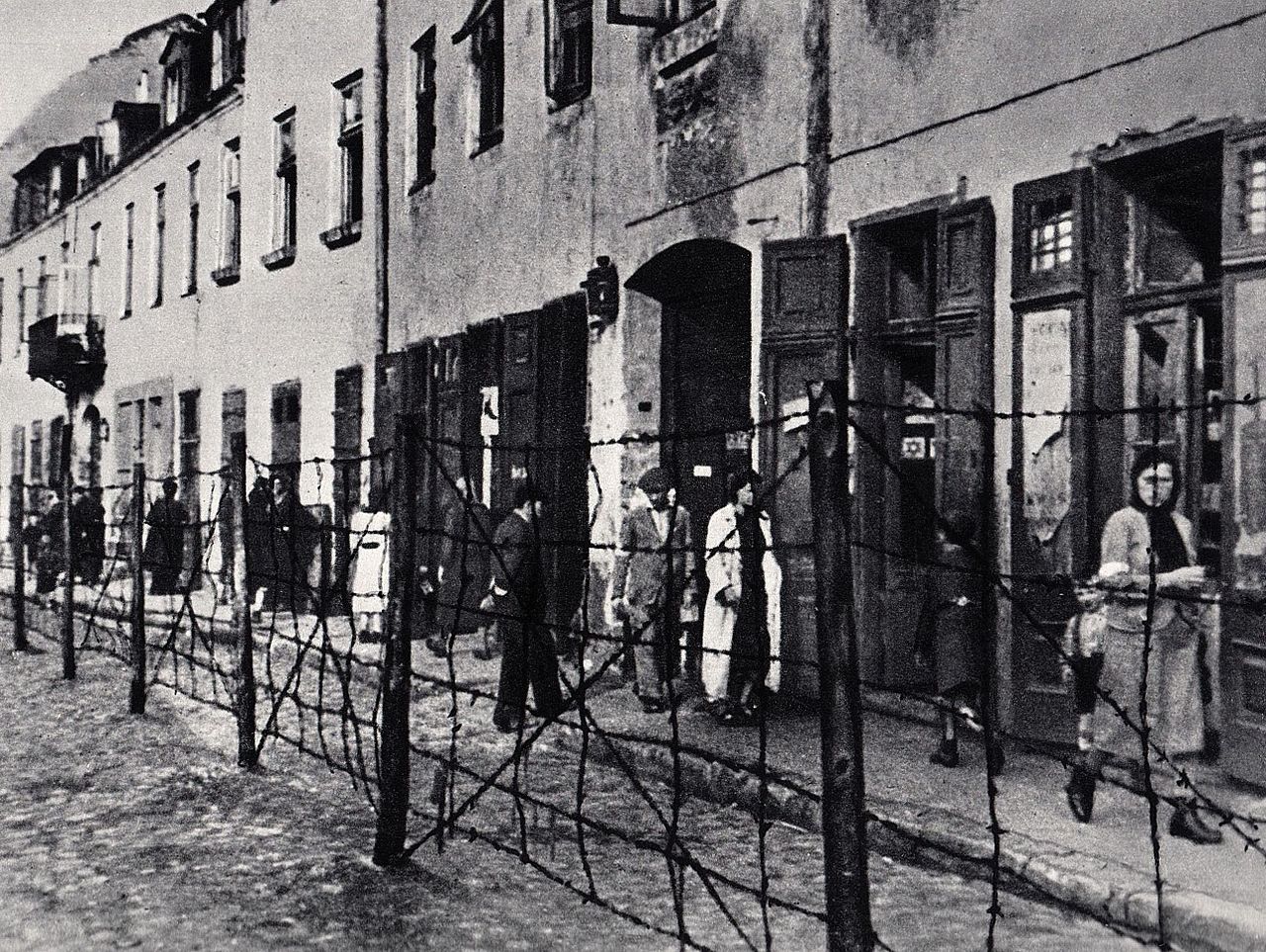Mitchell Duneier’s Ghetto: The Invention of a Place, the History of an Idea is not so much a full history of the ghetto as a place as it is an intellectual history of those who have studied it. Duneier profiles four black social scientists and community leaders who engaged with the physical spaces frequently described as the ghetto: a segregated space where European Jews, and later, American black communities, would be isolated, cut off from economic enfranchisement, and systematically disempowered by external forces of control. From their work, Duneier extracts a number of conclusions, among them that there is nothing natural about the forced concentration of poor people into isolated, underserved, overcrowded, and over-policed physical spaces.

Farrar, Straus & Giroux.
292 pages, $28
This may seem almost absurdly self-evident—particularly to those for whom it is not an abstraction but a reality. Yet Duneier’s book documents a long history of sociological theories that have attempted to describe ghettos as naturally occurring phenomena and that have long blamed inhabitants of the ghetto for the conditions imposed on them.
Take the case of the Warsaw ghetto. A poster outside it pictured “a man with a louse nestled in his beard” above the caption “Jews are crawling with the typhus.” Ignoring that typhus had spread in the Warsaw ghetto as the result of the deplorable living conditions imposed by the Nazis, the poster framed the physical separation of Jews as a public health necessity. As Duneier writes, “the consequences of ghettoization provided an apparent justification for the original condition.”
You don’t need to look far to see how this same circular logic has been deployed in the war on poor people. Crumbling infrastructure, low-performing schools, high levels of incarceration—all are cited frequently as proof of the inferiority of people living in ghettos, and thus as justification for their circumstances. What these critiques never acknowledge is that these conditions have largely been imposed by external forces: poor infrastructure and failing schools as a result of neglect and disinvestment; high levels of incarceration due to discriminatory policing and community-destroying legislation like the Rockefeller Drug Laws.
Many of the thinkers profiled in Ghetto identify versions of this vicious cycle, even as they cannot escape their own battles with it. They are largely professionally successful—but their work also gets overshadowed, co-opted, and threatened with defunding. An illustrative example unfolds early in Duneier’s story, in his chapter on the black sociologist Horace Cayton. The setting: late 1930s Chicago, where Cayton, a graduate student in the University of Chicago’s famed sociology department, was at work on a massive, unprecedented study of the city’s black community. Cayton and his team of more than 150 researchers, most of whom were not professionals but community members themselves, had spent years collecting almost 10,000 interviews, hanging out in social spaces, and attending community events, all with the aim of gaining a complex, multi-dimensional understanding of black life in Chicago. The study had been funded by the WPA, but the grant was so meager that Cayton was unable at times to pay his team—and even took money from mobsters to plug the holes.
Enter Swedish economist Gunnar Myrdal, hired by the Carnegie Corporation to produce a report from a neutral, “outsider” perspective on the American problem of racial inequality. Myrdal heard of Cayton’s work and, according to letters and meeting notes unearthed by Duneier, tried to convince him to contribute his research to the Carnegie project. But Cayton was not going to allow himself to be exploited. Cayton stipulated his conditions for working for Myrdal: full credit for his scholarship and enough funding to enable him to finally publish his own book.
It doesn’t take a wild imagination to guess how this story ends. Myrdal was unwilling to meet Cayton’s conditions, and the book he published, An American Dilemma, was not only absent of Cayton’s research but largely lacked any examination of racism in the North. An American Dilemma, widely hailed as the definitive race study of its time, hinged on the thesis that racism is a Southern problem whose solution lies in the consciences of white liberals. As Duneier points out, Myrdal may have reached a different conclusion had he benefited from Cayton’s exhaustive research on the racism that was alive and well in segregated Chicago.
Crumbling infrastructure, low-performing schools, high levels of incarceration—all are cited frequently as proof of the inferiority of people living in ghettos, and thus as justification for their circumstances.
Horace Cayton’s book was eventually published, but remains overshadowed by Myrdal’s. The story is emblematic of the struggles faced by Ghetto’s luminous thinkers, whose research often chafed against the same intersections of race and power that they hoped to study. In 1960, social psychologist and community leader Kenneth Clark’s social service organization faced defunding when he refused to “accept the paternalism of a donor who insisted she knew better than they did what the children of Harlem needed”; and despite the bombshell success of his book on Harlem, he was never appointed by that neighborhood’s elite Columbia University. William Julius Wilson’s The Declining Significance of Race (1978) was appropriated by right-wing politicians in their crusades against welfare and race-conscious policy.
“Ghetto,” of course, is a term that originally referred not to American black communities but to European Jewish ones, and Duneier provides a brief overview of this genealogy. The word was first used to describe segregated medieval Jewish communities in places like Venice and Rome. When Hitler introduced the Nazi practice of removing Jews from their communities and resettling them in small, tightly controlled settlements regulated by barbed wire and armed guards, he borrowed the medieval word “ghetto,” and described the arrangement as a natural descendant of earlier periods of Jewish segregated living. But the medieval ghetto had nothing in common with the Nazi ghetto. While medieval ghettos were places “in which Jewish life was able to survive and sometimes even flourish,” the Nazi ghetto was “simply a link in the larger chain of execution that resulted in the death of 6 million Jews.”
Duneier puts the blame for this sleight of hand at least in part on American social scientists, who failed to flag the difference. In allowing Nazis to paint the Warsaw ghetto and others like it as simply a “continuation of a medieval tradition,” social scientists missed an opportunity to open a conversation about the “variations in both human flourishing and social control that are found wherever people are restricted in space.”
The name stuck. As the Nazi ghetto became familiar to American audiences, some communities began to borrow its name to describe a very different kind of segregation they saw within their own borders: restricted urban black communities, or black ghettos. A chart created by Duneier shows the parallel spikes in the usage of “black ghetto” and “Warsaw ghetto” in 1940s literature.
In 2004, 60 years after the use of “ghetto” crossed over to American shores, Geoffrey Canada opened the Promise Academy in one of the most famous neighborhoods to bear that label: Harlem. Canada is the founder of Harlem Children’s Zone, the widely celebrated experiment in which Canada and his board of wealthy philanthropists have attempted to transform the fortunes of poor families in a small, focused area of Harlem.
Canada is the final thinker Duneier profiles in Ghetto. Far from painting the Zone as an unmitigated success, he presents a number of issues with the Canada model. He is critical of Harlem Children’s Zone’s role in advancing a neoliberal agenda by applying private, philanthropically oriented fixes to structural problems. But despite these criticisms, Ghetto spends regrettably scant time discussing the inherent conflict of interest present when economic equality projects take their funding and direction from those who have benefited most from inequality. Given Duneier’s well-argued point that the ghetto “is a phenomenon of ongoing external domination and neglect” by outside actors including the real estate and finance industries, it’s hard to imagine that Geoffrey Canada’s corporate benefactors are the right people to entrust with its future.
Perhaps that’s why this book doesn’t end on a particularly high note. Of all of the lessons Duneier takes from the scholarship he explored, the one he ends on is the American capacity for “moral dissonance”—the inclination to focus solely on the plight of one’s own community and to ignore, or rationalize, the conditions down the street.
Again and again, Ghetto’s subjects disprove Myrdal’s idea that the awakening of the white conscience is all that’s needed to end racial inequality in America. They deal with this awareness in different ways: Wilson tries to de-emphasize race, hoping to appeal instead to anti-poverty sentiment; Geoffrey Canada turns to a small number of powerful donors, thus avoiding the need to rely on widespread white “sacrifice.” Though none of these initiatives turn out to be the golden ticket, they all reflect the same awareness that, as Duneier writes of Cayton’s conclusions, “change is driven by economic necessity and political expediency, not by any obligations that Americans feel to their Christian-democratic ideals.”
There are no magic solutions in Ghetto, but the book makes it clear that any attempt to undo the disenfranchisement of the ghetto will have to wrestle with the restrictions based on race, income and wealth that built its walls in the first place.
Naomi Gordon-Loebl is a writer and educator in Brooklyn.






0 Comments